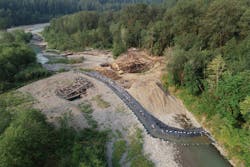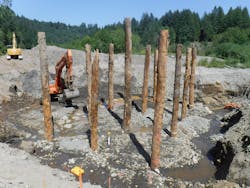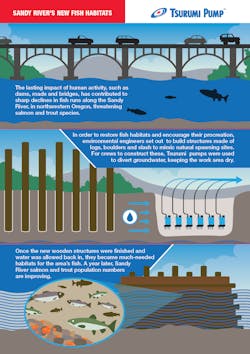Human activity has been a major contributor to significant declines in fish runs in the rivers of the Pacific Northwest. Damming, pollution, and urban development have all contributed to the decline.
One of the country’s most popular salmon runs takes place in the waters of northwestern Oregon, where every year hundreds of thousands of fish take the perilous trip from the Pacific Ocean up the Columbia River and into its tributaries, returning to their place of birth to spawn and renew their life’s cycle. Since the roundtrip is done only once in their lifetimes for some species, its success is crucial to the survival of the wildlife in the region.
On the Sandy River, a 56-mile long tributary of the Colombia River in northwestern Oregon, the lasting impact of a former hydroelectric dam, channelization (building of waterways for cargo transport), and road and bridge construction have posed serious threats to the delicate balance of the area’s animal and plant species, in particular fish runs for salmon and steelhead.
In 2007, the Marmot Dam was removed, allowing the Sandy River to flow freely for the first time since its construction in 1913. Since then, numerous projects have been underway to restore the river and make upstream habitat more accessible to migratory fish, bringing the watershed into compliance with the Endangered Species and Clean Water acts. In the past, the area had been dredged for gold and, more recently, the impacts of a nearby dam and road/bridge construction all contributed to a decrease in fish populations, particularly salmon.
Portland Water Bureau, Oregon Metro, and the Oregon Parks and Recreation Department commissioned Biohabitats, an ecological restoration organization, to build new procreation habitats for salmon at two sites along Sandy River. The first in Oxbow Regional Park, and the second in Dabney State Recreation Area, about 30 miles west of downtown Portland. At Oxbow Regional Park, the organization excavated and reactivated a historic 2,200-foot long side channel. At the Dabney Recreation Area, a landslide had buried a stream channel and caused it to flow straight to the Sandy River rather than following its longer, historic path.
Biohabitats used built environments known as engineered log jams (EJL) along the banks of the two sites to emulate natural streamflow and processes. In addition to providing flood diffusion and reducing sediment transportation and erosion, ELJs also act as fish spawning refuges, providing a relatively safe setting for fish to lay and fertilize eggs.
“Think about ELJs as subterranean skyscrapers, made of logs, boulders, and slash,” says Jacques Varvel, an ecological restoration specialist at Biohabitats. “The whole point of erecting these structures along the river’s side channels is that they work as spawning grounds, providing a relatively calm and safe environment for the fish to procreate before returning to the river and the ocean.”According to Varvel, ELJs help the fish reconnect to their food plain, making more food available for juveniles, so they grow bigger before moving to the ocean, increasing their survivability rates.
To erect the log structures along Sandy River side channels, Biohabitats needed to dig 40-foot holes to build their foundation. The biggest challenge was keeping these holes dry during construction. To make sure that there would be no water on the channels, it was crucial to use reliable pumps that could operate continuously.
“We used six Tsurumi KRS2-B6 15-horsepower electric submersible pumps to dewater the holes. They operated 24/7 for nearly three months at a time during the two summers we worked in the area,” Varvel says. “We battled both surface and groundwater, even as we were able to divert most of the side channel flow.”
Varvel says that working at such pristine, protected natural areas poses a series of challenges.
“It’s really important we go pro: we have to be able to count on the equipment we use, we have to be able to move large volumes of water reliably, consistently, and we have to have the support so when things go bad we can rectify the situation immediately,” he says.
Biohabitats partnered with CESSCO, a Portland, OR-based sales and rental house to provide pumps for the project. CESSCO has been a Tsurumi partner since 1989 and has a strong reputation in providing pumps and power generators on similar rehabilitation projects in the Pacific Northwest.
“One of the project’s goals was to keep impact at a minimum, and that’s why we recommended electric submersible pumps,” says Casey Perry, a pump and power sales and rentals specialist at CESSCO. “The pumps allowed for the construction of a very sturdy structure that can withstand flooding and other once-in-a-while weather events.”
The ELJs were designed to endure 100-year floods. The vertical logs were securely bolted into concrete foundations to be able to handle large water upsurges. With unexpected runoff during construction also being a concern, it was important that the pumps were capable of handling high volumes of water to keep the project on track. The KRS2-B6 pumps were placed in fish cages, which have screens to prevent fish from being sucked in.
The KRS2-B6 pumps boast a high-chrome impeller and a 1735-rpm motor, ensuring slower tip speed on the impeller. This promoted longevity when pumping the sand, rock particles, and other debris that may have been washed into the channel.
The natural areas where the project took place are managed by the Portland Water Bureau, which supplies the city with drinking water; Metro, the regional planning organization; and the Oregon Parks and Recreation Department. Biohabitats worked closely with the agencies to adhere to regulations and conditions for the ELJs to be built.
“Once the work is done, the sites have to look like we were never there—no excavator tracks, no debris of any kind are left behind,” Varvel says. “The best way to minimize our impact in these environments is to get the work done as quickly as you can. Instead of diverting the channel water, we chose to pump the water out, which makes the construction job easier. Using pumps allows us to do the work much faster and better.”
According to Biohabitats, in total, more than 1,350 pieces of locally sourced large wood, 1,800 tons of boulders, and 1,500 cubic yards of slash were used in this ecological restoration project.
As a testament to the project’s success, Biohabitats was awarded the “Engineering Excellence Award—Small Project of the Year 2019.”
“The best part of these interventions is coming back a year later to see that it is working,” says Varvel. “You see fish coming and spawning. The Sandy River is one river in the Portland area in which the fish population numbers are improving. And that’s really our end-goal.”
About the Author

Jeff Davis
Jeff Davis is a regional sales manager with Tsurumi Pump. He has 23 years of sales management and training experience in the pump industry. He earned his B.A. degree in psychology at Carson Newman University, and has served in the U.S. Navy as an aviation electronics technician.


